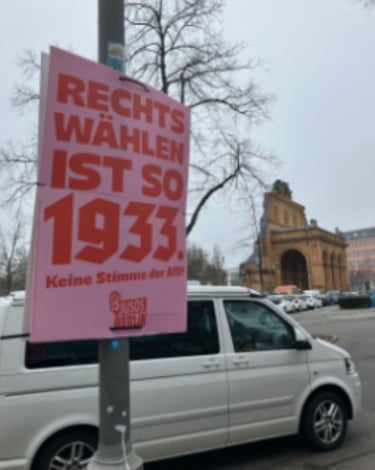While counting ballots - 22/02/2025
GERMAN ELECTIONS
Brody. L, Anna Vogt, Jakob van Ooijen
2/22/20253 min read
As I walked along Friedrichstraße, pedestrians hurried past under a gray sky, while ubiquitous election advertisements hinted at impending change. It was calm at noon; walking on the slightly frozen slick pavement wasn’t too cold. The city felt almost static here, its rhythm driven by the comings and goings of people.
Passing Checkpoint Charlie, I paused before a small section of the Berlin Wall remnants. Surrounding it were large backdrop panels depicting a brief history of the Cold War and photos of young victims shot by guards at the Berlin Wall. Most tourists appeared somewhat somber as they lingered moving slowly whilst taking pictures. Behind me was a group of excited young Brits; one wearing shorts animatedly recounted a recent football match held in Germany. Nearby was an inexpensive fast-food joint catering to tourists, selling fries and waffles while energetic beats from the kitchen played Say You Will Never by Lian Ross.
Continuing on my way, I noticed repeated faces of politicians; one poster featuring Merz had been defaced with “FCK NZS.” Politicians from CDU, SPD, and FDP stared back at me in a row while Scholz smiled from further away; I was not sure if I, or anyone would feel comfortable with those gazes as I stepped over melting snow, crunching beneath my feet.
Not far from the bridge, Schlossbrücke, an oddly mismatched small parade passed by—a group of seven or eight young men riding a multi-person bicycle through a line of red lights. Accompanied by electronic music, they shouted at pedestrians while a group of young girls wearing fur hats laughed and posed for pictures nearby. A sign next to them read “DDR Museum, 200 meters.” Behind me loomed the Berlin Cathedral; its lower marble columns were nearly blackened with age as Protestant saints gazed into the distance from their lofty perches—Huldrych Zwingli entirely shrouded in darkness while his bronze cross still gleamed brightly.


Out of some instinctive desire for self-comfort, I decided to visit the DDR Museum first before returning to Berlin Cathedral. However, upon my return to the church, what filled my mind wasn’t horror at peering into historical abysses but rather an overwhelming frustration at feeling toyed with. The DDR Museum largely resembled a theme park sustained by tacky souvenir shops rather than an educational space. In an exhibition hall no larger than an underfunded university classroom, visitors crowded together; older folks appeared indifferent while two young people on a school trip busily kissed each other. A girl with thick glasses stared vacantly at an image of Honecker while several children played with replicas of East German toys.
The exhibits were not only sparse but also presented in an overly interactive format. Which further transformed East Germans' lives devoid of political freedom into a nostalgic alternative lifestyle. Everything had been simplified; forty years of East German life were casually divided into several panels with just a few lines explaining their isolation and suffering—how they suddenly found courage from who knows where. “Aha! Kids, see? This is how East Germans were deceived by communists and Russians,” was the impression this so-called DDR Museum left me with. This infantilization of the former DDR can still be found today: In a 2018 Deutschlandfunk interview, Christiane Thiel, a school chaplain and former DDR citizen was asked about what and who German media was still overlooking in the former DDR: She replied that the question made it seem like they were little children or in a zoo. Additionally, she also compared it to a climate conference: “The people from Tuvalu say: "Our islands are drowning and you are flying to go on holiday." It's the same thing when we say here in the East we were robbed after 1989. The work biographies have been destroyed. That sounds so pitiful and so reproachful. It's not being heard.”
I realized that East Germans' overwhelming preference for AfD might stem from deeper reasons yet to be fully explored because here in the capital city—stepping into the DDR Museum—I saw no stories belonging to East Germans themselves. Their stories are not just absent from exhibits in the museum but in the remaining memory of the DDR itself. Writers of that era, whose primary role it is to keep their stories alive, are unheard – excluded from school curricula, overlooked in bookstores, and dismissed as part of German culture. An entire history reduced to shame; its people left without a sense of belonging. Parties like the AfD offer what mainstream politics does not: recognition of the East German identity.
East Germans’ lives continued long after the fall of the Berlin Wall, and this museum failed even to acknowledge them as double (or twice) victims in this narrative.
Brody .L, Anna Vogt, Jakob van Ooijen
